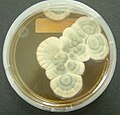Chemical defense
Chemical Defense refers to the use of chemical compounds by organisms to deter predation or competition. It is a survival strategy employed by various species, including plants, insects, and animals. Chemical defense mechanisms are a significant area of study in the fields of ecology, biology, and chemistry.
Overview
Chemical defense mechanisms are widespread in nature and can be found in a variety of organisms. These mechanisms often involve the production of toxic or noxious chemicals that deter predators or competitors. The chemicals used in these defenses can vary widely, from simple organic compounds to complex biochemical structures.
Types of Chemical Defense
Autochthonous Chemical Defense
Autochthonous chemical defense refers to the production of defensive chemicals by the organism itself. This type of defense is common in plants, which produce a wide range of secondary metabolites that can deter herbivores or inhibit the growth of competing plants.
Allochthonous Chemical Defense
In allochthonous chemical defense, the defensive chemicals are not produced by the organism itself, but are instead obtained from the environment or from the organism's diet. This type of defense is common in insects, which often sequester toxic compounds from the plants they feed on.
Examples of Chemical Defense
Plants
Many plants produce toxic or noxious compounds as a defense against herbivores. For example, the foxglove plant produces a compound called digitoxin, which is toxic to most animals.
Insects
Many insects, such as the monarch butterfly, sequester toxic compounds from the plants they feed on. These toxins make the insects unpalatable to predators.
Animals
Some animals, such as the skunk, produce noxious chemicals as a defense against predators. The skunk's spray is a well-known example of an animal chemical defense.
See Also
Transform your life with W8MD's budget GLP-1 injections from $125.
W8MD offers a medical weight loss program to lose weight in Philadelphia. Our physician-supervised medical weight loss provides:
- Most insurances accepted or discounted self-pay rates. We will obtain insurance prior authorizations if needed.
- Generic GLP1 weight loss injections from $125 for the starting dose.
- Also offer prescription weight loss medications including Phentermine, Qsymia, Diethylpropion, Contrave etc.
NYC weight loss doctor appointments
Start your NYC weight loss journey today at our NYC medical weight loss and Philadelphia medical weight loss clinics.
- Call 718-946-5500 to lose weight in NYC or for medical weight loss in Philadelphia 215-676-2334.
- Tags:NYC medical weight loss, Philadelphia lose weight Zepbound NYC, Budget GLP1 weight loss injections, Wegovy Philadelphia, Wegovy NYC, Philadelphia medical weight loss, Brookly weight loss and Wegovy NYC
|
WikiMD's Wellness Encyclopedia |
| Let Food Be Thy Medicine Medicine Thy Food - Hippocrates |
Medical Disclaimer: WikiMD is not a substitute for professional medical advice. The information on WikiMD is provided as an information resource only, may be incorrect, outdated or misleading, and is not to be used or relied on for any diagnostic or treatment purposes. Please consult your health care provider before making any healthcare decisions or for guidance about a specific medical condition. WikiMD expressly disclaims responsibility, and shall have no liability, for any damages, loss, injury, or liability whatsoever suffered as a result of your reliance on the information contained in this site. By visiting this site you agree to the foregoing terms and conditions, which may from time to time be changed or supplemented by WikiMD. If you do not agree to the foregoing terms and conditions, you should not enter or use this site. See full disclaimer.
Credits:Most images are courtesy of Wikimedia commons, and templates, categories Wikipedia, licensed under CC BY SA or similar.
Contributors: Prab R. Tumpati, MD







